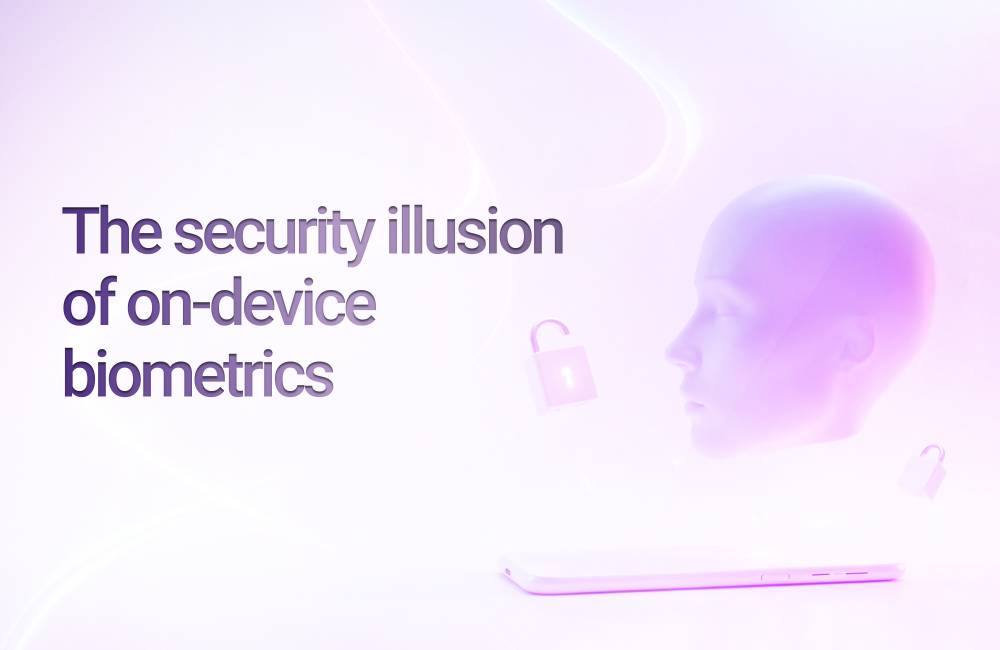Face ID isn’t enough: The security illusion of on-device biometrics Written on

For years, Face ID and other on-device biometrics have been paraded as the holy grail of user authentication: fast, frictionless, and secure. But let's get one thing straight:convenience does not equal security, and in high-stakes industries like banking, fintech, and iGaming, it’s not just a weak assumption,it's a dangerous one.
While billions of devices now rely on facial recognition and fingerprint scanning, the reality is that on-device biometrics are inherently limited. They’re local, siloed, and offer no real control over identity ownership or verification integrity. It’s time we admit the truth: Face ID is built for unlocking a phone, not securing your business.
What’s really at stake: Trust, control, and accountability
The game isn’t about making logins faster. It’s about eliminating fraud, verifying users with confidence, and ensuring compliance in a privacy-first world. On-device biometrics simply can’t meet that challenge.
Let’s break down the risks of on-device biometrics:
· They relly on low security standa5ds: Protection depends on the weakest device, not your policies.
· Businesses have no control: Manufacturers dictate authentication rules, not you.
· They’re easy to bypass: PINs and backup options make biometric checks easy to override.
· The UX is fragmented: Users must re-enroll biometrics on every device, creating friction.
· There’s weak identity assurance: Devices are authenticated, not people, making account takeovers easy.
· They’re vulnerable to fraud: Lost, shared, or spoofed devices can grant full access to unauthorized users.

Decentralized biometric authentication: A smarter, safer future
Here’s the good news: you don’t need to abandon biometrics, you just need to liberate them from the device.
Decentralized biometric authentication flips the script. Instead of anchoring identity to hardware, it uses advanced cryptography and privacy-preserving design to verify users securely across any device, channel, or ecosystem, without storing sensitive data in central databases.
Let’s zoom in on what this actually means:
Zero-knowledge. Total control.
Decentralized systems allow users to prove who they are without revealing who they are. Identity is verified, but personal data stays private. This reduces business compliance risks and enhances user trust.
Cross-platform, cross-journey
Customers don’t live on one device. With decentralized biometrics, identity becomes portable and persistent, enabling seamless onboarding, login, and re-authentication across apps and devices. That’s huge for sectors like mobility or hospitality, where journeys span multiple touchpoints.
Smarter fraud prevention
When you decentralize authentication, you gain visibility across the entire identity lifecycle, not just isolated device events. That means better anomaly detection, better trust signals, and better decisions at every stage of the user journey.
What regulators and attackers know that you don’t
Let’s not pretend this is theoretical. Regulators are circling. From GDPR to eIDAS 2.0, there’s a growing push for user-centric, verifiable identity frameworks. On-device biometrics don’t meet the bar. They’re unaccountable and opaque. Decentralized identity, on the other hand, aligns with the very principles regulators are now demanding: privacy, transparency, and user control.
Meanwhile, attackers have already moved on. Biometric spoofing tools are getting cheaper, smarter, and more convincing. Combine that with phishing, SIM swaps, and synthetic identities, and it’s clear: relying solely on a selfie scan tied to one phone isn’t just outdated — it’s negligent.
Why businesses must rethink authentication
Still clinging to Face ID as your security layer? Ask yourself:
· Are you comfortable letting the weakest device dictate the security of your customers’ transactions?
· If a user’s device is lost, shared, or spoofed, do you still know who’s behind the screen?
· Can your authentication model adapt to users who switch devices, use multiple platforms, or move across borders?
If the answer is “no” (or “maybe”), you’re stacking risk. Decentralized biometric authentication isn’t a “nice to have.” It’s the foundation for trusted digital experiences that scale across regions, channels, and use cases. Whether you're onboarding fintech customers, verifying drivers, or preventing fraud in iGaming, you need an authentication model that’s as dynamic as your business.
Final word: Stop locking identity in a black box
If you’re serious about security, scale, and compliance, it’s time to look beyond Face ID and start thinking bigger.
Download our new ebook From Risk to Trust to see how decentralized biometric authentication transforms security without compromising user experience.






